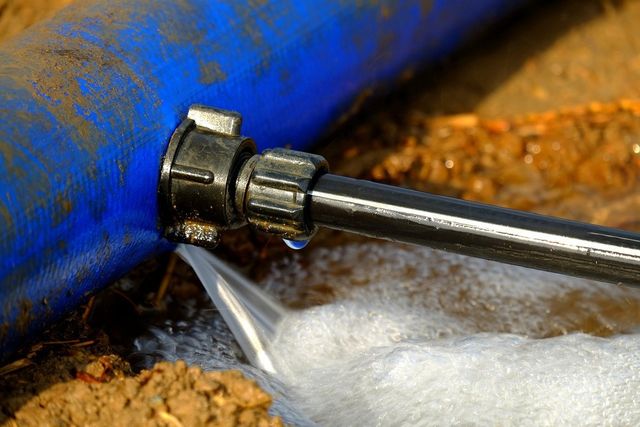Overview To Water Leakage Discovery At Home
Overview To Water Leakage Discovery At Home
Blog Article
The content down below on the subject of Locating water leaks is seriously intriguing. Check it out yourself and decide what you think of it.

Early detection of leaking water lines can alleviate a prospective catastrophe. Some little water leakages might not be noticeable.
1. Examine the Water Meter
Every home has a water meter. Examining it is a surefire manner in which helps you find leakages. For beginners, switch off all the water resources. Ensure nobody will certainly flush, use the faucet, shower, run the washing machine or dishwasher. From there, most likely to the meter as well as watch if it will change. Since no one is utilizing it, there need to be no movements. That shows a fast-moving leakage if it moves. Similarly, if you detect no changes, wait a hr or two as well as inspect back again. This means you may have a slow leak that can also be underground.
2. Check Water Intake
If you identify sudden adjustments, in spite of your usage being the same, it suggests that you have leaks in your plumbing system. A sudden spike in your bill suggests a fast-moving leakage.
At the same time, a steady rise on a monthly basis, despite having the exact same practices, shows you have a slow-moving leakage that's additionally gradually intensifying. Call a plumber to extensively inspect your residential property, specifically if you really feel a warm area on your flooring with piping beneath.
3. Do a Food Coloring Examination
When it comes to water intake, 30% comes from toilets. If the shade somehow infiltrates your dish throughout that time without flushing, there's a leakage in between the container and bowl.
4. Asses Exterior Lines
Do not fail to remember to check your exterior water lines as well. Examination faucets by affixing a garden hose. Should water seep out of the link, you have a loosened rubber gasket. Change this and also ensure all connections are limited. If you've obtained a lawn sprinkler, it will help get it expertly examined as well as preserved yearly. One little leak can lose lots of water and also increase your water bill.
5. Evaluate the circumstance and check
Home owners should make it a behavior to inspect under the sink counters as well as also inside cabinets for any type of bad odor or mold development. These 2 warnings indicate a leakage so timely attention is required. Doing routine evaluations, also bi-annually, can conserve you from a major trouble.
If you understand your residence is already old, keep a careful eye on your heating systems, hoses, pipes and so on. Check for stainings as well as compromising as the majority of devices as well as pipelines have a life expectancy. They will certainly also normally wear away due to tear and also put on. Do not wait for it to rise if you think dripping water lines in your plumbing system. Call a specialist plumber right now so you don't end up with a horrible mess in your home.
Early discovery of leaking water lines can alleviate a potential calamity. Some small water leakages might not be visible. Checking it is a surefire means that helps you uncover leaks. One tiny leak can lose heaps of water and increase your water expense.
If you suspect dripping water lines in your plumbing system, don't wait for it to rise.
WARNING SIGNS OF WATER LEAKAGE BEHIND THE WALL
PERSISTENT MUSTY ODORS
As water slowly drips from a leaky pipe inside the wall, flooring and sheetrock stay damp and develop an odor similar to wet cardboard. It generates a musty smell that can help you find hidden leaks.
MOLD IN UNUSUAL AREAS
Mold usually grows in wet areas like kitchens, baths and laundry rooms. If you spot the stuff on walls or baseboards in other rooms of the house, it’s a good indicator of undetected water leaks.
STAINS THAT GROW
When mold thrives around a leaky pipe, it sometimes takes hold on the inside surface of the affected wall. A growing stain on otherwise clean sheetrock is often your sign of a hidden plumbing problem.
PEELING OR BUBBLING WALLPAPER / PAINT
This clue is easy to miss in rooms that don’t get much use. When you see wallpaper separating along seams or paint bubbling or flaking off the wall, blame sheetrock that stays wet because of an undetected leak.
BUCKLED CEILINGS AND STAINED FLOORS
If ceilings or floors in bathrooms, kitchens or laundry areas develop structural problems, don’t rule out constant damp inside the walls. Wet sheetrock can affect adjacent framing, flooring and ceilings.
https://www.servicemasterbyzaba.com/blog/how-to-detect-water-leakage-in-walls/

I'm just very involved in Hacks to detect leaks and I'm hoping you enjoyed reading the blog post. Feel free to take a moment to distribute this page if you appreciated it. Thank you so much for taking the time to read it.
Report this page